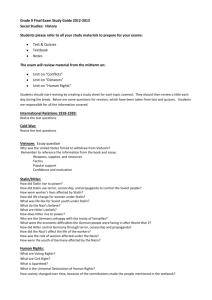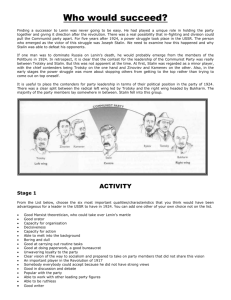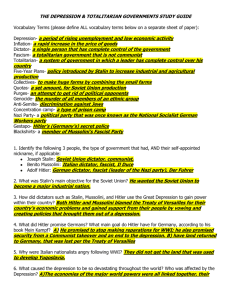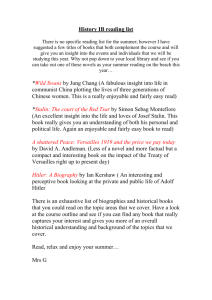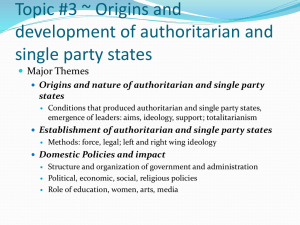Topic #3 ~ Origins and development of authoritarian
advertisement
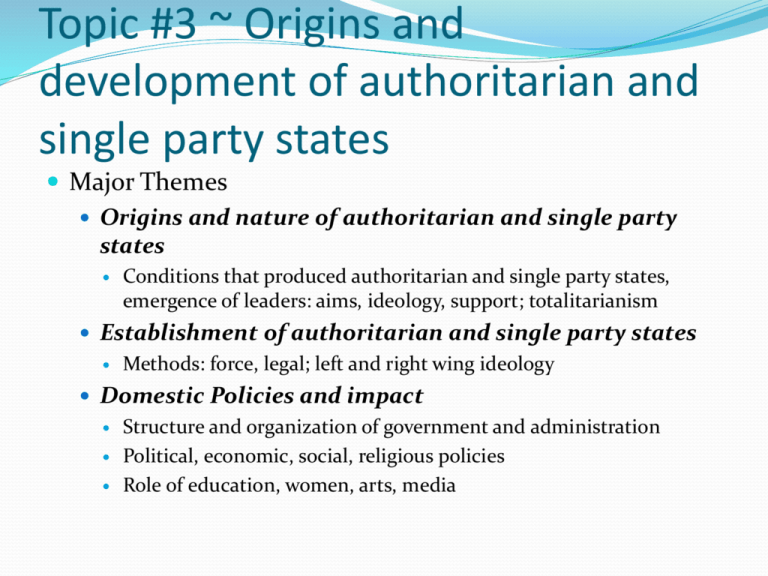
Topic #3 ~ Origins and development of authoritarian and single party states Major Themes Origins and nature of authoritarian and single party states Conditions that produced authoritarian and single party states, emergence of leaders: aims, ideology, support; totalitarianism Establishment of authoritarian and single party states Methods: force, legal; left and right wing ideology Domestic Policies and impact Structure and organization of government and administration Political, economic, social, religious policies Role of education, women, arts, media Material for detailed study America: Cuba – Castro Europe: Hitler – Left Wing: Communism ~ Stalin & Castro Germany, USSR – Stalin Mussolini – Italy Right Wing: Fascism ~ Hitler & Mussolini GROUP ACTIVITY In your group you will look at and define two single party states Origin Rise to Power Beliefs Economic Policy Foreign Policy Actions RISE OF STALIN Characteristics of Authoritarian States Do not rise from mass movements or revolution Arise when conservative regime imposes undemocratic measures They can arise following military coups Authoritarian regimes are firmly committed to maintaining traditional structure and values Leninism Organized Marx’s ideas for political organization Need for small leading group of revolutionaries Created tension b/w Lenin & Trotsky (fellow revolutionary) Trotsky said that small group could lead to dictator Both though revolutionary stages could happen quickly Marxism-Leninism Term created by Stalin—used after death of Lenin (1924) Considered “official” ideology “Socialism in one country” Political purges Used to promote the single-party state Stalinism Dictatorial type of rule Reject socialist democracy: Rejected: government is in the hands of the people Rejected: Immediate recall of elected representatives National interests over the interests of world revolution Totalitarian Dictatorships Dictator imposes their will on: Party State Society QUOTE: “Stalin’s police state is not an approximation to, or something like, or in some respects comparable with Hitler’s. It is the same thing, only more ruthless, more cold-blooded…and more dangerous to democracy and civilized morals” The Russian Civil War 1918, Lenin is the target of a failed assassination The Lenin led government launches the “Red Terror” and has over 300,000 suspected sympathizers executed The Russian Civil War will be waged between the White Army who seek a return to Tsarist rule and the Red Army that is protecting communist rule and hoping to spread as well The White Army will inflect brutality on its own people with mass torture and executions Lenin will attempt to spread communism in Europe but will be easily repulsed by Poland The U.S., France, Britain and Japan will provide assistance to the White Army because they fear communism in Russia Russia does annex Georgia and Armenia Political & Economic Problems 1921 -1924 What happened to Russia? Civil War broke after the October Revolution (This is when the Provisional Gov’t is overthrown) Bolsheviks (the Red Army) vs. The Whites The Bolsheviks won in 1921 Major policy disruptions that caused problems War Communism All industry was nationalized and strict centralized management was introduced. State monopoly on foreign trade was introduced. Discipline for workers was strict, and strikers could be shot Obligatory labor duty imposed onto "non-working classes." Prodrazvyorstka – taking agricultural surpluses from peasants to redistribute. Food and most commodities were rationed and distributed in urban centers in a centralized way. Private enterprise became illegal. Military-style control of railroads. How do we summarize “war communism”? Ability to for the Bolsheviks to take total control Historian Richard Pipes argued: Bolsheviks used excuse of war communism to eliminate private property, commodity production and market exchange. The leaders expected an immediate and large scale increase in economic output New Economic Policy ~ Lenin Adopted in 1921 Allowed small, privately owned firms and traders to operate Established an alliance with peasants Allowed them to sell surplus to private markets State kept control of major industry and foreign trade Effect of the NEP Left feared a restoration of capitalism Right argued that it was essential Though they overlooked fight between kulaks and nepmen Kulak—rich peasant Nepmen—traders who gained money under NEP Leon Trotsky vs. Joseph Stalin After Lenin’s death in 1924 there was a power struggle within Russia of who would take over Trotsky was the man most feared by the other senior members. Trotsky refused to compete for leadership. He was absent at Lenin’s funeral saying that Stalin had told him the wrong date (hummmm). In reality he seems to have lacked the political will to fight. This left the door open for…….Stalin Leon Trotsky Trotsky was exiled to Turkey. Stalin played the other members of the politburo off against each other until they lost their government posts. The Rise of Joseph Stalin Joseph Stalin was born into a poor class family, He was fascinated with stories dealing with overcoming insurmountable odds He is a harsh man, he does not attend his mothers funeral and he does not attempt to retrieve his son from a prisoner of war camp in 1917 The Rise of Joseph Stalin Stalin rises through the ranks of politics through ruthlessness and cunning He played his opponents against one another and he used his poor background to appeal to the people During the Russian Revolution he will serve as a commissar He achieves complete power by arresting or executing his supporters who put him in power The Rise of Joseph Stalin He will put the country on a crash course of collectivization in which the Russian state would feed itself The Agriculture sector will be moved to working in heavy industry, this will cause low food production and starvation 14 million are believed to have been killed because of this program The Rise of Joseph Stalin He achieves complete power by purging the ranks of his supporters who put him in power Grand trials will be held in the public, this instills fear and at the same time loyalty In 1929 he becomes the Secretary General of the Communist Party The Rise of Joseph Stalin “Russian Motherhood” under the regime was glorified as it sought to increase its population To increase female participation in the state, women were given the right to vote in 1920 Stalin’s Rise To Power Key Dates 1922 - Appointed General Secretary of the Communist Party 1924 - Death of Lenin 1927 - Introduces the Five Year Plan and collectivization 1929 - Emerging leader of the USSR What circumstances aided Stalin in his successful rise to power? Even though Trotsky was most likely to succeed Lenin and take on the lead as Party Leader, yet he was very much unpopular by the public and lost mass support when he did not show up for Lenin's funeral (which was set up by Stalin!!!) The people interpreted his non presence as a sign of great disrespect to Lenin, and thereby Trotsky was on his way to become less and less popular. What methods did Stalin employ to overcome his rivals in the leadership struggle? Stalin portrayed himself as Lenin's follower in Soviet propaganda in an effort to justify his efforts to take power Lenin was widely revered by the Russian working class and class-conscious workers world wide, particularly those in the communist parties of Europe. His theory of Socialism in One Country rather than Permanent Revolution was in stark contrast to the principled socialist stand of Lenin and his internationalist outlook. Stalin played one side against the other to take power: First, he allied with Zinoviev and Kamenev to cover up Lenin’s Will and to get Trotsky dismissed (1925). Trotsky went into exile (1928). Then, he advocated ‘Socialism in one country’ (he said that the USSR should first become strong, then try to bring world revolution) and allied with the Rightists to get Zinoviev and Kamenev dismissed (1927). Stalin put his supporters into the Politburo. Finally, he argued that the NEP was uncommunist, and got Bukharin, Rykov and Tomsky dismissed (1929). What was the nature of Stalin's ideology? "Socialism in one country" The USSR followed the left-wing ideology of communism, although this was adapted by Stalin according to what they perceived to be the needs of the state. According to Marxsim, the proleteriat were meant to rule, but in the Soviet Union this can hardly be said to have been the true when the Communist Party had so much control. The reason for the dictatorship of the party was due to Russia's backwardness and that the dictatorship of the proletariat could not take place until people had been educated to have correct values. What were Stalin's aims Stalin wanted to strengthen Russia by modernization and industrialization, in order for her to compete with the big powers! 5 Year Plans – Series of economic plans to modernize and industrialize Russia Collectives - this involved the creation of collective farms in which peasants worked cooperatively on the same land with the same equipment. This was intended to improve the efficiency of agriculture and eliminate the "kulak" class of landowners, which was deemed hostile to the Soviet regime, while improving the position of poor peasants. The disruption and repression associated with collectivization was a primary cause of the famine of 1932, which resulted in millions of deaths. Rise of Mussolini Immediate Post-WW I Italy Fascism was a product of a general feeling of anxiety and fear among the middle class: Fears regarding the survival of capitalism. Economic depression. The rise of a militant left. A feeling of national shame and humiliation at Italy’s poor treatment by the other Entente leaders after World War I [especially at Versailles]. Immediate Post-WW I Italy In 1920 the Italian Socialist Party organized militant strikes in Turin. Fear if economic chaos spreading… “Black Shirts” violently attacked the Socialists. Benito Mussolini (1883-1945) Originally a Marxist By 1909, convinced that a national rather than an international revolution was needed. Edited the Italian Socialist Party newspaper: Avanti! [Forward!]. Benito Mussolini (1883-1945) The war was a turning point for Italy. Returning combat soldiers would form a new elite New elite would transform Italian politics and society Benito Mussolini (1883-1945) The war was a turning point for Italy. Returning combat soldiers would form a new elite New elite would transform Italian politics and society Mussolini Comes to Power 1921 election Fascists included in the political coalition bloc of P. M. Giovanni Giolitti’s government [they win 35 seats]. October, 1922 Mussolini threatened a coup d’etat. “March on Rome” 25,000 Black Shirts staged demonstrations throughout the capital. Mussolini Forms a Government King Victor Emmanuel III refused to sign a law giving the Italian military the ability to stop the Fascists. Invited Mussolini to join a coalition government 1925 Mussolini seized dictatorial powers during a political crisis The Fascists Consolidate Power (1925-1931) Independent political parties & trade unions were abolished. Freedom of the press was curbed. Special courts created to persecute any political opposition. National police force created [with a secret police component]. State “Corporatism” 1926 The National Council of Corporations created. Guilds of employers and employees established to manage the 22 sectors of the economy. Supported by small capitalists, low-level bureaucrats, and the middle class The goal harmonize the interests of workers, managers and the state by abolishing class warfare. The reality This system stalled technological progress and destroyed workers’ rights. The Fascist Family The Fascists encouraged the development of large families. Education “Let us salute the flag in the Roman fashion; hail to Italy; hail to Mussolini.” Textbooks emphasized: The glorious pat of the ancient Romans. The limitations imposed upon the present inhabitants by geography and the West. The imperial destiny that awaited Italy’s future development. Emphasis on Physical Fitness Anti-Semitism 50,000 Jews lived in Italy in the 1930s. Mussolini did NOT implement an extermination program in Italy. 75% of Italian Jews survived World War II. 8,000 died in German extermination camps. 1938 anti-Semitic laws passed Manifesto degli Scienziati Razzisti [The Manifesto of the Racist Scientists]. Excluded foreign Jews [most of them were sent to German death camps]. Forbade all Jews from teaching. Excluded Jews from serving in the government or in the military. Mussolini Was Hitler’s Role Model Rise Of Hitler Hostile Peace On June 28, 1919: Treaty of Versailles ratified: War Guilt Clause No self-determination for many Germans Anschluss Rhineland occupied by the French Demilitarization Reparations Weakness of the Government Proportional Representation Vote for parties NOT people Reichstag (like Congress/Parliament) President elected every 7 years, they choose the chancellor Weakness of the Government Spartacus League (KDP) •German Communist Party •Extreme left wing socialist movement •Tried to overthrow the government through violent revolution •Refused to work with SPD (Social Democratic Party) Conservative Elite Not as hostile, but openly disliked the government Many veterans, judges, senior civil servants Nationalists Had Freikorps: Conducted political murders in the name of nationalism SOURCE A: “In the eyes of the right, the Republic was associated with the surrender, a shameful and deliberate act of treachery, and the peace treaty a further act of betrayal. The fact that the new republican institutions were democratic added to the hostility. It was openly said that loyalty to the fatherland required disloyalty to the republic” (Bullock Hitler, A Study in Tyranny) Hitler Joins Politics National Socialist German Worker's Party (NSDAP) Disorganized party Did not recognize the Weimar Republic Nationalist Freikorps joined Anti- Semitism Hitler became the chairman of the party in 1921 The Munich Putsch (The Beer Hall Putsch) Hated the Weimar Republic November 8, 1923: Hitler held rally at a Munich Beer Hall and proclaimed “revolution!” Led 2,000 armed "brown-shirts" (SA) to take over the Bavarian government. (Lost) Won national attention Ruhr crisis and the great inflation were at their height. Prison Sentence Tried for Treason (gets 5 yrs. in prison) Wrote Mein Kampf (My Struggle) in prison Outline his hatred of Jews and Communists Gave a history of the Nazi Party Government Intervention Hitler decided to seize power constitutionally rather than by force of arms. Golden Era for the Weimar Republic First Nazi election led to only 12 seats (2.6%) of the vote Hitler spoke to mass audiences Wanted German people to resist the rule of Jews/Communists Talked of creating a new empirerule the world for 1,000 years. Nazis Gain Power In 1930Nazis vote went from 3% to 18% In 1932Hitler ran for President and won 30% of the vote (Nazis held 107 seats) Hitler lost the presidential election to Paul von Hindenburg Hitler offered Vice-Chancellor (rejects it) Franz von Papen named chancellor—has major problems Kurt von Schleicher replaced von Papen Convinced of Nazi decline von Schleicher and von Papen tried to harness their energy Nazis Gain Power Hitler, Hindenberg and von Papen formed a coalition “Backstairs Intrigue” Hitler called for new election Massive propaganda campaign Reichstage Fire Blamed the Communist Party for starting the fire…Hindenberg issued a decree for the “Protection of the People”….took away peoples civil liberties & with Communist party gone set the table for the Nazis Nazis won 43.9% of the total vote The Reichstag Fire, February 1933 Reichstag building partially destroyed by fire. Hitler convinced Hindenburg to take strong action, and the president suspended freedom of speech and the press and other civil liberties. The Enabling Acts (1933) On March 23, 1933, the Reichstag passed the Enabling Act, which gave dictatorial authority to Hitler's cabinet for four years. Three Phases of Creating an Authoritarian State Phase I (1933-1934): Hitler consolidated his authority through the destruction of all other political parties Phase II (1935-1937): militarization and conversion of all Germans to enthusiastic support of National Socialism. Phase III (1935-1939): rapid, diplomatic and military actions to gain support while getting rid of opposition elements. The Nuremberg Laws (1935) These laws defined a Jew as any person with at least one Jewish grandparent. The Nuremberg Laws deprived Jews of their rights as citizens, and Jews were barred from marrying nonJews. Kristallnacht (1938) Nazis organized a campaign of mob violence known as the Kristallnacht (Night of Broken Glass) destruction of synagogues and Jewish-owned businesses. Jews were forced to wear a yellow star of David German Jewish community was compelled to pay for damages. Treaty of Versailles Total Control of State by a Dictator Black Tuesday 1929 - stock market crashes Great Depression during 1930s Increasing influence of new political parties that emphasize state control -For example: Communism, Nazism, Fascism HITLER BECAME CHANCELLOR OATH OF LOYALTY TO HITLER THE REICHSTAG FIRE THE ENABLING ACT DEATH OF PRESIDENT HINDENBURG THE NIGHT OF THE LONG KNIVES How did Hitler consolidate his power? Nazi Military State Gestapo (secret police) SS (Defense Corps) Black Shirts, elite guard unit formed out of SA SA – Stormtroopers, “Brown Shirts” Nationalism, Rallies, Book Burnings, Propaganda, Youth Movement Hitler’s Storm Troopers SA – Sturmabteilung – Brown Shirts – Original Parliamentary wing of the Nazi Party – Used to maintain control @ speeches, parties & intimidating Jewish citizens Led to problems w/ the military. Rumors of a military coup; SA became disposable Propaganda Propaganda was skillfully used by the NSDAP in the years leading up to and during Adolf Hitler's leadership of Germany (1933–1945). National Socialist propaganda provided a crucial instrument for acquiring and maintaining power, and for the implementation of their policies, including the pursuit of total war and the extermination of millions of people in the Holocaust. Propaganda Hitler believed masses could be won over easily Censorship (Party controlled 2/3 of private newspapers) Radio Slogan (“Heil Hitler”) Movies Decorations on buildings Anti – Bolshevik Poster Consolidation Complete in 1938 1934-Night of the Long Knives – Political purge between June 30th & July 2nd 1934 where Nazi regime carried out a series of political murders Slowly began to transition the military into a Nazi force 1935: Restoration of conscription—peacetime army of 500,000 Military didn’t like the SS suppose to be a domestic police force Technically part of the “war time army” Some didn’t like the expansionist policies (Lebensraum) of the pace of rearmament War minister von Blomberg and Commander in Chief von Fritsch both were dismissed Hitler became war minister. Rise of Castro Importance of CUBA 90 miles off of the coast of Florida 1901 Platt Amendment – 1934 stated US had right to oversee Cuban economy, veto any international agreements & intervene in Cuba’s domestic policies 1934 – 1959 Military Dictator General Fulgencio Batista ~ supported by US ~ allowed increasing US control of Cuban economy & political developments US retained important naval base at Guantanamo Fidel Castro Unhappy with Batista’s regime and Cuba being little more then a US satellite Castro was son of wealthy plantation owner Stood for congress in 1952 Led attack on the army’s Moncada Barracks in 1953 = failure (July 26th Movement) Imprisoned / released in 1955 / exile in Mexico December 1956 – leads small force of revolutionaries and lands in Cuba – US places embargo not shipping weapons to both sides – Guerrilla War ensued - Batista flees Cuba for Dominican Republic Castro’s revolution Fidel Castro looked for US aid initially US looks at Castro as similar to Arbenz in Guatemala with his plans for land, health, and welfare reform 1959 CIA using Cuban exiles and hatching plans to disrupt the Cuban economy and destabilize Castro’s gov’t Cuba nationalized almost all US-owned companies = US suspends Cuba sugar imports and US placed an embargo on virtually all trade Cuba signed a trade agreement in 1960 with SU which gave Cuba credit for $100 million credit to purchase equipment while SU promises to purchase 2 million tons of sugar a year for next 4 years Castro also signs trade agreement with communist China Castro & Bay of Pigs invasion By 1960 Castro had nationalized the economy and came to rely on Cuban Communist Party to provide administration for reform programmers Castro established trade relations with every communist state including SU, China, N. Korea and N. Vietnam CIA convinced Eisenhower to approve training of an invasion force of right-wing Cuban exiles to overthrow Castro April 15th, 1961 Kennedy authorized Cuban exiles with CIA pilots to carry out air raids to knock out Cuban air force Castro’s response Next day Castro announced Cuba intended to follow ‘socialist’ road in order to complete revolution SU sending large aid packages, including weapons April 17th 1961 – 1400 Cuban exiles land invasion at the Bay of Pigs Attempted invasion was quickly defeated = US humiliated Why does Cuban missile Crisis happen Kennedy remained determined to overthrow Castro Attempted assassination, planes to bomb or napalm sugar and tobacco fields, CIA agents sabotaging oil refineries, and sank Cuban merchant ships Castro fearing another invasion asks Khrushchev for protection…May 1962 Soviet weapons on the rise Cuban Missile Crisis Oct. 14th 1962 US U-2 spy plane returned with images of missile sites under construction & Soviet missiles had arrived ‘The Thirteen Days’ – closest US and SU come to war Kennedy Two Responses US would mount a naval blockade of Cuba then US troops would invade island Khrushchev issued a reply that Soviet ships would not respect blockade October 28th Khrushchev pulls missiles out of Cuba and 18 SU ships turn around and go home Compromises Khrushchev sends personal letter to Kennedy Letter offered: Oct. 26th Withdrawal of Soviet missiles from Cuba on condition US lifted its blockade of Cuba and promised not to invade island Oct 27th Khrushchev sends 2nd letter – asks US to remove missiles from Turkey Oct. 27th Kennedy responds to the first letter – US would remove blockade if SU missiles withdrawn from Cuba…Kennedy agreed US missiles would be removed from Turkey (would not go public) If this doesn’t happen US invades Cuba the next day Cuban Revolution & Cold War As early as 1963 US continued trying to assassinate Castro Castro hoped that Cuban Revolution would inspire other countries in Central & Latin America and Caribbean to revolt US = feared this Castro felt USSR used Cuba in its Global Contest and differences between the two would follow 1968 Castro would publicly support the Warsaw Pact & invasion of Czechoslovakia


